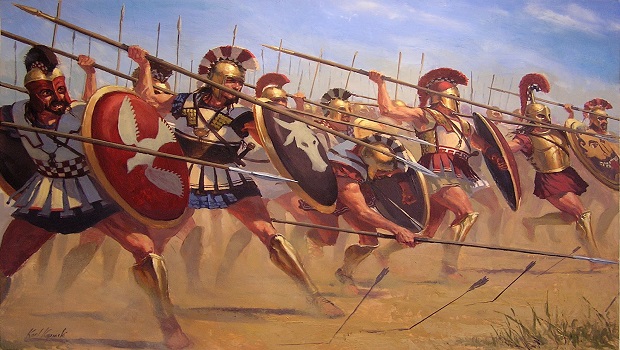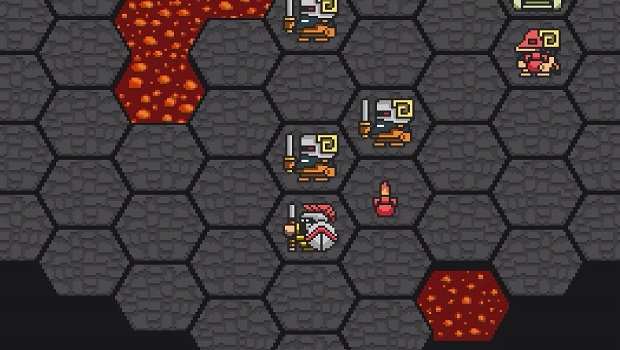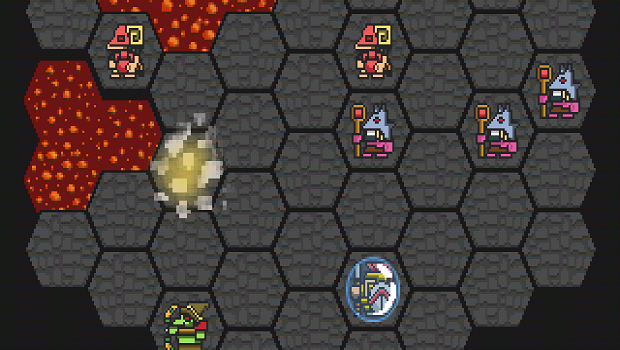Hoplite is available for download here.
Every now and then a game will come along, seemingly out of nowhere, and arrest large amounts of my time. Such was the case with a little strategy game on Android (and iOS) called Hoplite. The game consists of guiding your little hoplite soldier across a procedurally generated battlefield, acquiring upgrades and slaying monsters, in search of the golden fleece. Not only is it fun, challenging and free (there is a more content rich premium version), the game does a wonderful job of transferring 8th century BC (-ish. Historians can never agree on dates like this) battlefield tactics meant for large groups of fighting men, onto a single figure.
Hoplites were the fighting men of the Greek city-states that existed long before the idea of one unified Greek country. I’m talking about your Athenians, Spartans, Macedonians and the like. While the Spartans were renowned for their military prowess, most hoplites were farmers and artisans who only underwent basic military training. Therefore they needed tactics that were simple yet effective. So the famous phalanx formation was born: a shield wall bristling with pointy bits.
Our little Greek soldier in Hoplite isn’t part of a phalanx, but what he loses in numbers he makes up for with moxie. Just because he is alone does not mean he doesn’t employ hoplitic fighting practices. The game is turn based and takes place on a grid, where you and your enemies can move about one hexagon at a time. The hoplite and the demons steadily close the gap until they meet to attack. This mirrors how ancient armies met each other on the field of battle.
They would meet on a wide flat plain and advance towards each other at walking pace. Any faster and there was a risk of breaking the formation of the phalanx, exposing gaps in the line and losing the defensive advantage that a shield wall bestows. I got in touch with Magma Fortress’ Doug Cowley to ask him about his grids: “I was thinking more about ways I could encourage the player to keep moving around the map during combat. I put in the lunge and stab attacks because I didn’t want fighting to involve just standing in one spot tapping an attack button. I went with a turn based, grid system because I think it leads to more interesting, tactical decisions.“
The game certainly achieves this. It forces the player to anticipate actions. If I attack this demon, am I in an archer’s line of sight? Will I be able to strike at two enemies in one turn? Perhaps I should bypass them by leaping over this lava trench.
Attacking the non-ranged enemies head on will result in you taking a hit, whereas attacking from the side, at an angle will result in a successful attack for the player. How does this emulate actual hoplite battle techniques?
Instead of single avatars, visualise the player character as a line of 10 men in the grid tile, facing off against a line of 10 enemies in their grid tile. Head on, shields will meet shields, and the defence remains high. Coming in at an angle from left or right would open up the spaces of the enemy’s shields, highlight the gaps in the chain and allow your men’s spears greater space to work in.
The player line would also be able to bend around and attack the flanks, especially if the enemy was outnumbered. However since the use of reserve forces in battle was not conceived of before the 5th century BC, a battle was often decided by the formations initially placed in the field. The player needs to ensure they are attacking from an angle straight away.
The similarities don’t stop there. The little Greek has a shield bash move that is capable of pushing enemies back. An important aspect of the phalanx was having the rear ranks push forward, in order to keep the enemy off balance.
The lunge ability also represents a hoplite’s ability to attack at range using a long spear. Attacking from a position of safety at range highlights how the troops could strike out from behind their shields. Phillip II of Macedon would eventually outfit his troops with the longer sarissa (a spear of 18 feet in length), improving upon this advantage.
I asked Mr. Cowley if his intention all along had been to communicate these ancient strategies of war through the single avatar in the game? He admits that he didn’t have that in mind at all when he was developing the game, but that he likes the sound of it.
Maybe if the game had not been called Hoplite these connections never would have been drawn. Yet here we are with one Greek soldier personifying, as accurately as can be expected in a game of this scale, the fundamentals of ancient city-state warfare. This may not have been Doug Cowely’s intention, but perhaps subconsciously this was a glimmer of an idea that wanted to get out, and the team at Magma Fortress have done a fine job either way.



